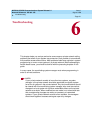
MERLIN LEGEND Communications System Release 6.1
Network Reference
555-661-150
Issue 1
August 1998
Network Management
Page 5-26Uniform Dial Plan Routing
5
UDP Routes 5
In UDP routing, routes 1–4 are associated with patterns, which are assigned first
by associating non-local dial plan extension ranges with those patterns. You can
use up to 20 patterns and up to 50 extension ranges. A pattern can be assigned to
as many extension ranges as necessary. Each route has various attributes (FRL,
digit absorption, and so on) for call delivery.
Route 1 has the highest priority and should specify a pool of tandem PRI trunks if
such facilities are connected to the system. Pools should contain the same type of
facilities. If a caller uses Callback, the call queues for Route 1 only. Usually, PSTN
routes should have the highest FRL numbers, which are the most restrictive and
are only included for use by particular users when tandem trunk pools are
unavailable.
In many cases, only one pool may be needed. However, multiple pools can help
prioritize certain types of calls and maximize the use of shared facilities.
You can use inspect to review existing routes.
Valid Entries
Pattern (1–20)
Routes (1–4)
Facility Restriction Levels 5
FRLs assigned to extensions apply not only to ARS calls but also to calls for non-
local UDP extensions connected by private trunks to your local system. Use care
in assigning FRLs both to extensions and to UDP routes. For example, if a user
must be restricted from toll calls on your local system, you may need to plan UDP
routes’ FRLs to be unrestricted, so that the user can reach necessary non-local
UDP extensions.
Use the following guidelines to assign a FRL to each UDP route. The FRL ranges
from 0 (least restrictive) to 6 (most restrictive). When a user makes a call that
requires UDP routing, the user’s extension FRL (or in some cases, remote access
barrier code FRL) must be equal to or higher than the route FRL in order for the
call to go through. When a call arrives at a remote private networked system, the
remote access default COR FRL specified in the remote system for the type of
tandem trunk carrying the call (tie or non-tie) replaces the user’s extension FRL in
the comparison to the UDP or ARS outgoing route FRL. For an extension FRL or
default COR FRL, a value of 0 is the most restrictive, and a value of 6 is the least
restrictive. The interaction of FRLs is described in “Facility Restriction Levels and
Remote Access” on page 5.
The factory setting for each FRL is 3.


















